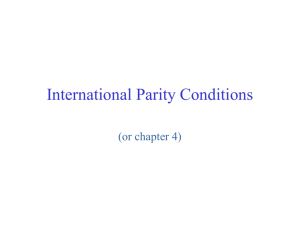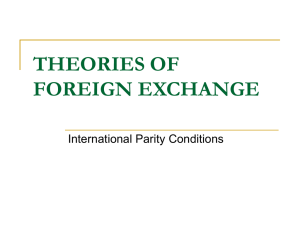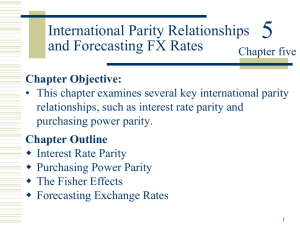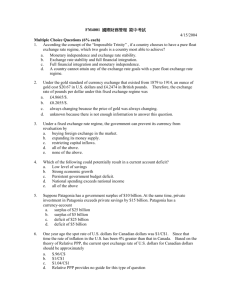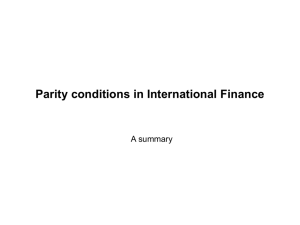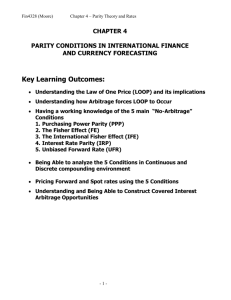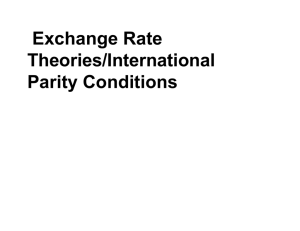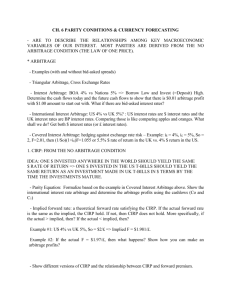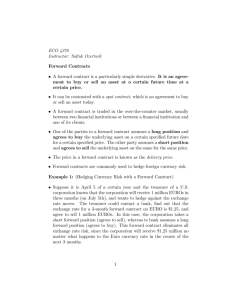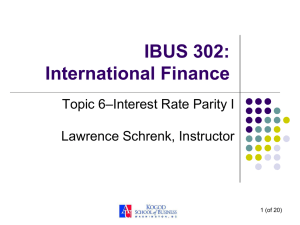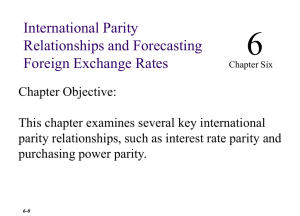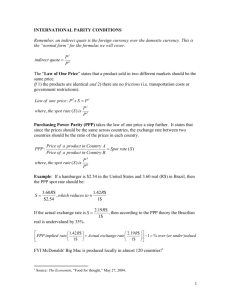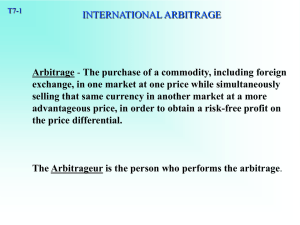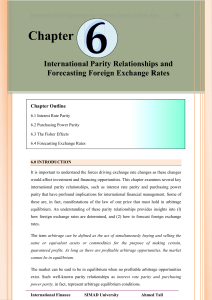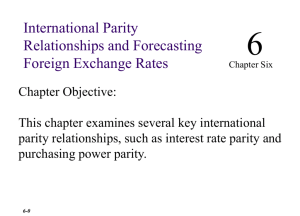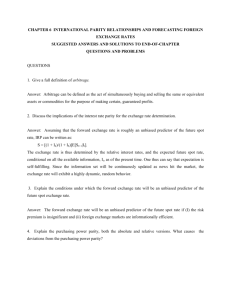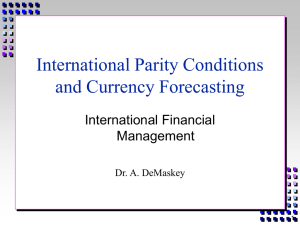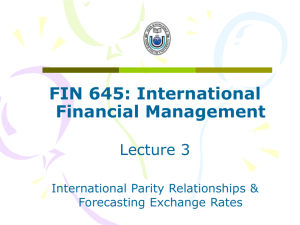solution 6
advertisement
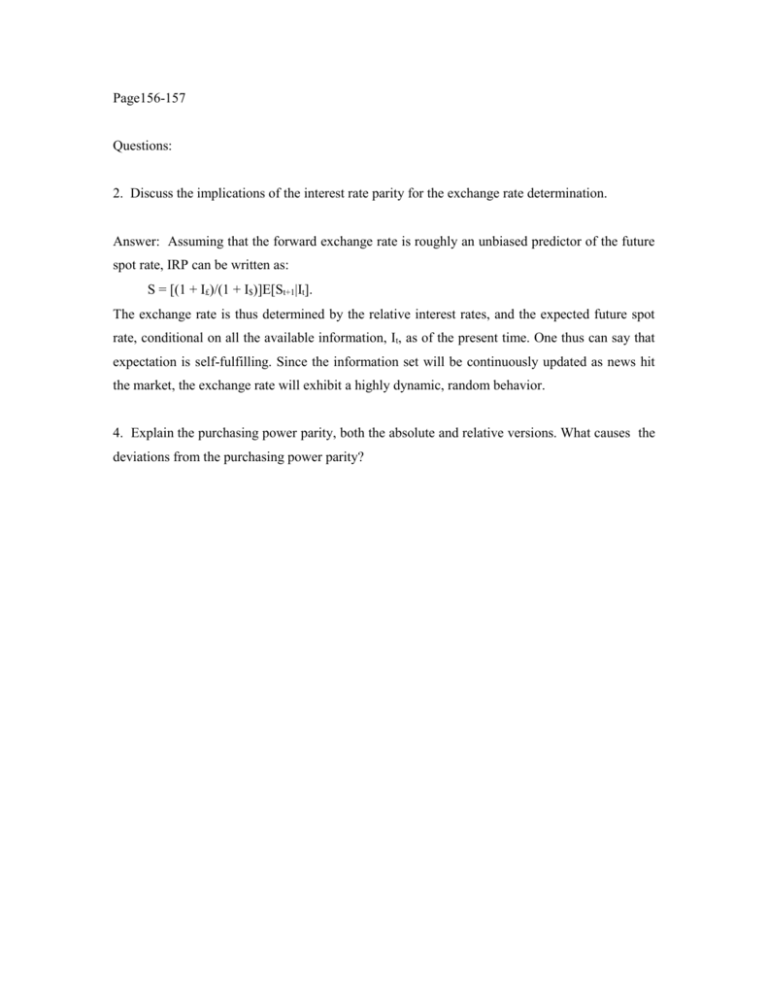
Page156-157 Questions: 2. Discuss the implications of the interest rate parity for the exchange rate determination. Answer: Assuming that the forward exchange rate is roughly an unbiased predictor of the future spot rate, IRP can be written as: S = [(1 + I£)/(1 + I$)]E[St+1It]. The exchange rate is thus determined by the relative interest rates, and the expected future spot rate, conditional on all the available information, It, as of the present time. One thus can say that expectation is self-fulfilling. Since the information set will be continuously updated as news hit the market, the exchange rate will exhibit a highly dynamic, random behavior. 4. Explain the purchasing power parity, both the absolute and relative versions. What causes the deviations from the purchasing power parity? Answer: The absolute version of purchasing power parity (PPP): S = P$/P£. The relative version is: e = $ - £. PPP can be violated if there are barriers to international trade or if people in different countries have different consumption taste. PPP is the law of one price applied to a standard consumption basket. 10. Explain the following three concepts of purchasing power parity (PPP): a. The law of one price. b. Absolute PPP. c. Relative PPP. Answer: a. The law of one price (LOP) refers to the international arbitrage condition for the standard consumption basket. LOP requires that the consumption basket should be selling for the same price in a given currency across countries. b. Absolute PPP holds that the price level in a country is equal to the price level in another country times the exchange rate between the two countries. c. Relative PPP holds that the rate of exchange rate change between a pair of countries is about equal to the difference in inflation rates of the two countries. Note: PPP is not useful for predicting exchange rates on the short-term basis mainly because international commodity arbitrage is a time-consuming process. PPP is useful for predicting exchange rates on the long-term basis. Problems: PROBLEMS 1. Suppose that the treasurer of IBM has an extra cash reserve of $100,000,000 to invest for six months. The six-month interest rate is 8 percent per annum in the United States and 6 percent per annum in Germany. Currently, the spot exchange rate is €1.01 per dollar and the six-month forward exchange rate is €0.99 per dollar. The treasurer of IBM does not wish to bear any exchange risk. Where should he/she invest to maximize the return? The market conditions are summarized as follows: i$ = 4%; i€ = 3.5%; S = €1.01/$; F = €0.99/$. If $100,000,000 is invested in the U.S., the maturity value in six months will be $104,000,000 = $100,000,000 (1 + .04). Alternatively, $100,000,000 can be converted into euros and invested at the German interest rate, with the euro maturity value sold forward. In this case the dollar maturity value will be $105,590,909 = ($100,000,000 x 1.01)(1 + .035)(1/0.99) Clearly, it is better to invest $100,000,000 in Germany with exchange risk hedging. 2. While you were visiting London, you purchased a Jaguar for £35,000, payable in three months. You have enough cash at your bank in New York City, which pays 0.35% interest per month, compounding monthly, to pay for the car. Currently, the spot exchange rate is $1.45/£ and the three-month forward exchange rate is $1.40/£. In London, the money market interest rate is 2.0% for a three-month investment. There are two alternative ways of paying for your Jaguar. (a) Keep the funds at your bank in the U.S. and buy £35,000 forward. (b) Buy a certain pound amount spot today and invest the amount in the U.K. for three months so that the maturity value becomes equal to £35,000. Evaluate each payment method. Which method would you prefer? Why? Solution: The problem situation is summarized as follows: A/P = £35,000 payable in three months iNY = 0.35%/month, compounding monthly iLD = 2.0% for three months S = $1.45/£; F = $1.40/£. Option a: When you buy £35,000 forward, you will need $49,000 in three months to fulfill the forward contract. The present value of $49,000 is computed as follows: $49,000/(1.0035)3 = $48,489. Thus, the cost of Jaguar as of today is $48,489. Option b: The present value of £35,000 is £34,314 = £35,000/(1.02). To buy £34,314 today, it will cost $49,755 = 34,314x1.45. Thus the cost of Jaguar as of today is $49,755. You should definitely choose to use “option a”, and save $1,266, which is the difference between $49,755 and $48489. 3. Currently, the spot exchange rate is $1.50/£ and the three-month forward exchange rate is $1.52/£. The three-month interest rate is 8.0% per annum in the U.S. and 5.8% per annum in the U.K. Assume that you can borrow as much as $1,500,000 or £1,000,000. a. Determine whether the interest rate parity is currently holding. b. If the IRP is not holding, how would you carry out covered interest arbitrage? Show all the steps and determine the arbitrage profit. c. Explain how the IRP will be restored as a result of covered arbitrage activities. Solution: Let’s summarize the given data first: S = $1.5/£; F = $1.52/£; i$ = 2.0%; i£ = 1.45% Credit = $1,500,000 or £1,000,000. a. (1+i$) = 1.02 (1+i£)(F/S) = (1.0145)(1.52/1.50) = 1.0280 Thus, IRP is not holding exactly. b. (1) Borrow $1,500,000; repayment will be $1,530,000. (2) Buy £1,000,000 spot using $1,500,000. (3) Invest £1,000,000 at the pound interest rate of 1.45%; maturity value will be £1,014,500. (4) Sell £1,014,500 forward for $1,542,040 Arbitrage profit will be $12,040 c. Following the arbitrage transactions described above, The dollar interest rate will rise; The pound interest rate will fall; The spot exchange rate will rise; The forward exchange rate will fall. These adjustments will continue until IRP holds. 4. Suppose that the current spot exchange rate is €0.80/$ and the three-month forward exchange rate is €0.7813/$. The three-month interest rate is 5.6 percent per annum in the United States and 5.40 percent per annum in France. Assume that you can borrow up to $1,000,000 or €800,000. a. Show how to realize a certain profit via covered interest arbitrage, assuming that you want to realize profit in terms of U.S. dollars. Also determine the size of your arbitrage profit. b. Assume that you want to realize profit in terms of euros. Show the covered arbitrage process and determine the arbitrage profit in euros. Solution: i$=1.4%, i€=1.35%, S($/€)=1/0.8=1.25, F($/€)=1/0.7813=1.2799 a. (1+ i $) = 1.014 < (F/S) (1+ i € ) = 1.03775758. Thus, one has to borrow dollars and invest in euros to make arbitrage profit. 1) Borrow $1,000,000 and repay $1,014,000 in three months. 2) Sell $1,000,000 spot for €800,000. 3) Invest €800,000 at the euro interest rate of 1.35 % for three months and receive €810,800 at maturity. 4) Sell €810,800 forward for $1,037,758. Arbitrage profit = $1,037,758 - $1,014,000 = $23,758. b. Follow the first three steps above. But the last step, involving exchange risk hedging, will be different. 5) Buy $1,014,000 forward for €792,238. Arbitrage profit = €810,800 - €792,238 = €18,562 6. As of November 1, 1999, the exchange rate between the Brazilian real and U.S. dollar is R$1.95/$. The consensus forecast for the U.S. and Brazil inflation rates for the next 1-year period is 2.6% and 20.0%, respectively. How would you forecast the exchange rate to be at around November 1, 2000? Solution: Since the inflation rate is quite high in Brazil, we may use the purchasing power parity to forecast the exchange rate. E(e) = E($) - E(R$) = 2.6% - 20.0% = -17.4% S0($/R$)=1/1.95=0.5128 E(ST) = So(1 + E(e)) = ($0.5128/R$) (1 - 0.174) = $0.4236/R$

